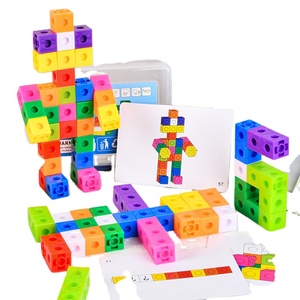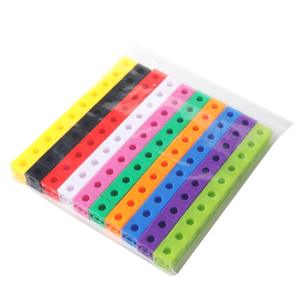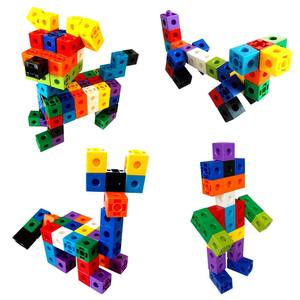(3389 products available)








































































































































































































Math blocks come in different types, which include the following:
Base ten blocks
Base ten blocks are among the most common types of math blocks for kids. They help children understand place value, addition, subtraction, and other fundamental math concepts. The blocks come in four types: unit cubes, long sticks, flat squares, and large cubes. Each block represents a different value. For example, the unit cubes represent one, long sticks represent ten, flat squares represent a hundred, and large cubes represent a thousand.
Fraction blocks
Fraction blocks are colored to show different fractions. They are useful in teaching kids how to add, divide, multiply, or subtract fractions. This is because children can see how the fractions relate to one another visually. Fraction blocks also assist in identifying equivalent fractions, grouping fractions, and understanding the concept of wholes.
Geometric blocks
Mathematical blocks include wooden or plastic blocks with different shapes and sizes. These blocks assist children in recognizing shapes, developing spatial awareness, and improving their ability to solve problems. Moreover, geometric blocks can be used to teach concepts related to mathematics, such as symmetry, patterns, and balancing equations.
Number blocks
Number blocks are simple wooden or plastic blocks that are usually colored and have numbers printed on one side. They help children learn how to count, recognize numbers, and do basic math operations like addition and subtraction. Kids can stack, line up, or arrange the number blocks in different ways to make learning fun and more hands-on.
Counting blocks
Counting blocks are small and come in different colors. They are used to help children learn how to count, group numbers, and understand basic math concepts. For example, kids can use the counting blocks to practice adding or taking away numbers to see how many are left in each group. The different colors of the counting blocks also make learning more exciting by allowing kids to sort and organize them in various ways based on their colors.
Math manipulatives
Math manipulatives are versatile tools that can be used to demonstrate many math concepts. They include counting chips, dice, play money, and other objects that can be touched and moved around. Math manipulatives help students learn math by allowing them to see and feel how numbers and quantities work together. This hands-on approach makes it easier for kids to understand difficult math ideas.
When buying math blocks for sale, business owners should consider the product's material. They should get blocks made from sturdy materials like non-toxic ABS plastic or wood. The blocks should also have smooth edges and finishes to ensure they are safe for kids. Ideally, blocks made from durable materials can withstand constant use and are easy to clean. Toys made from wood should have a non-toxic finish. Buyers should also look for blocks with a solid construction, such as glued or welded parts. Such blocks won't chip or break easily.
Business owners should get math blocks in various sizes and shapes. The sizes should be suitable for different age groups. For instance, large blocks are ideal for toddlers, while smaller ones are used by older kids. They should also get blocks in various shapes, such as circles, squares, and triangles. This will give kids an opportunity to learn about different shapes. Also, blocks in various sizes allow kids to engage in various activities like building towers and creating structures.
Buyers should get math blocks with additional features. For instance, some blocks have moving parts like wheels or hinges. Such features make the toys more interesting and fun for kids. They should also get blocks with interactive elements like puzzles, magnetic connections, or velcro. These elements encourage kids to think critically and solve problems. Moreover, they should get blocks with educational graphics like numbers, letters, or mathematical symbols. These graphics help kids learn how to count, add or subtract.
Buyers should consider the level of mathematical complexity that the blocks offer. For instance, they should have simple blocks with basic shapes and patterns for young learners. Also, they should have blocks with advanced features like movable parts, magnetic connections, or velcro. These elements will encourage kids to solve problems and think critically. The blocks should also come with materials that support learning in a structured way. For instance, they can have guides with suggested activities or educational booklets.
Buyers should consider how easy the math blocks are to store. They should come in a sturdy storage box or bag. This will make it easy to store and transport the blocks. More importantly, the storage container should have a clear lid or labels to help parents and kids identify the contents. This will ensure the blocks are always kept together.
Conceptual understanding
Math blocks help students comprehend concepts by allowing them to visualize and physically engage with the mathematical principles, thus enhancing understanding.
Interactive learning
These blocks make learning interactive and fun, encouraging hands-on exploration, which aids in better retention of mathematical ideas and fosters an interest in the subject.
Versatile applications
Math blocks are versatile educational tools that can be utilized to illustrate a wide array of mathematical concepts, ranging from fundamental operations to more intricate topics such as geometry and algebra.
Manipulative nature
Math blocks are tangible objects that students can touch, move, and arrange, providing a hands-on experience that facilitates learning through direct interaction with mathematical concepts.
Color-coding
Most math blocks have a color-coding feature that helps in differentiating sizes, shapes, or functions, thus enabling sorting and classification activities that enhance understanding of mathematical relationships.
Incremental sizing
The math blocks have sizes that are gradual, which promotes the development of spatial awareness and understanding of measurement and volume through activities involving stacking and comparing sizes.
Durable materials
Math blocks are made from sturdy materials like plastic or wood, ensuring they can withstand frequent handling and last longer while providing a solid, consistent resource for learning.
Portability
Many math blocks come in portable designs such as sets or storage containers, making it easy to transport them from one place to another, thus allowing for flexible use in different learning environments.
Clear labeling
Math blocks have distinct labels or markings that facilitate quick identification of their purpose, thus aiding in efficient organization and selection for specific educational activities.
Ensuring the safety and quality of math blocks is crucial for providing a reliable and durable learning tool. Here are some key considerations:
Material Safety
Math blocks should be made from non-toxic, BPA-free plastics or safe, durable materials. The materials used should be free of harmful chemicals such as lead, phthalate, or heavy metals. If the blocks are made of wood, they should be sourced from responsible and eco-friendly suppliers.
Durability
Math blocks should be able to resist chipping, cracking, or breaking. They should be made of strong materials that can endure frequent handling, dropping, and rough use by children. The blocks should be resistant to staining and easy to clean to maintain hygiene.
Design Safety
The edges and corners of the blocks should be rounded or smoothed to prevent cuts or injuries. Large blocks are safer for younger children to handle and play with, as they reduce the risk of choking hazards. There should be no small detachable parts that can be swallowed or inhaled by children.
Certifications and Compliance
Math blocks should be certified by reputable safety organizations or comply with relevant safety standards. They should meet the safety requirements set by organizations such as the American Society for Testing and Materials (ASTM) or the International Electrotechnical Commission (IEC).
Quality Assurance
Manufacturers should conduct quality control inspections to ensure each block meets the company's quality standards. They should test the blocks for durability, strength, and safety features before mass production. The blocks should undergo independent testing to verify their safety and quality claims.
Q1: How do math blocks benefit a child's learning experience?
A1: Math blocks enhance a child's learning by making difficult concepts easy to understand and introducing a tactile element to education. They help in the visual and practical understanding of numbers, which is essential for building a solid mathematical foundation.
Q2: What materials are commonly used in the construction of math blocks?
A2: Math blocks are typically made from long-lasting materials like wood, foam, plastic, or rubber, among others. Each material has its benefits, such as wood being eco-friendly and sturdy, while foam and plastic are lighter and more affordable.
Q3: What is the typical use of math blocks in an educational context?
A3: In schools, math blocks are used during interactive lessons where students are encouraged to touch and manipulate the blocks. Teachers often use them in group activities to promote teamwork and communication skills.
Q4: What safety considerations should be kept in mind when using math blocks?
A4: When using math blocks, one should consider using non-toxic materials with rounded edges to prevent injuries. Parents and teachers should also ensure that the blocks are of appropriate size for the age group to avoid choking hazards.
Q5: How can caregivers ensure that math blocks are used effectively at home?
A5: Caregivers can ensure that math blocks are used effectively by integrating them into daily activities and encouraging open-ended play. They can also guide children in using the blocks to solve problems or create structures related to schoolwork to reinforce learning.